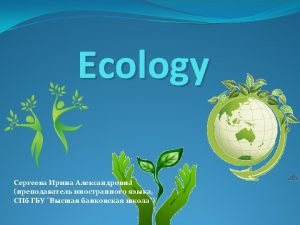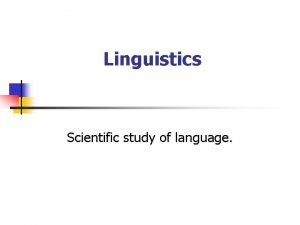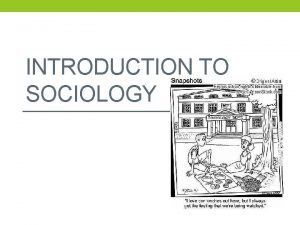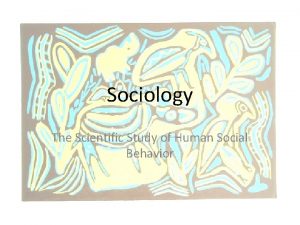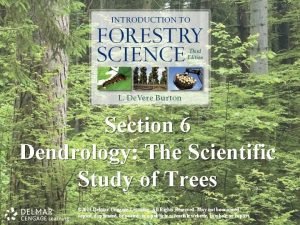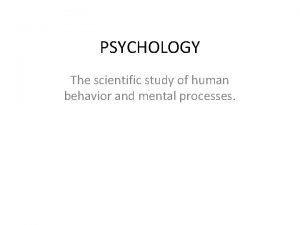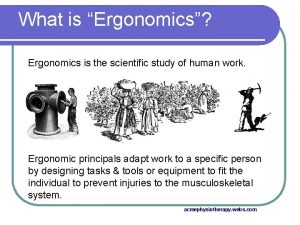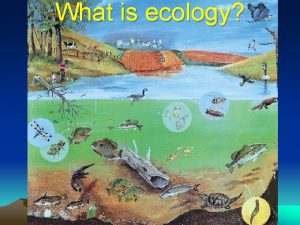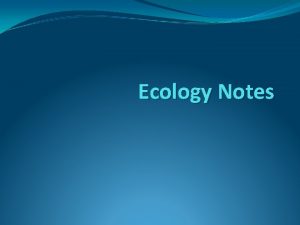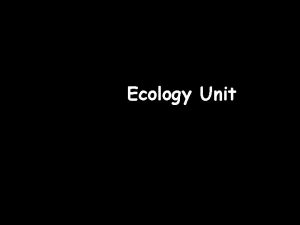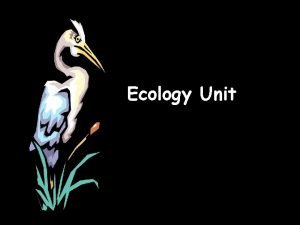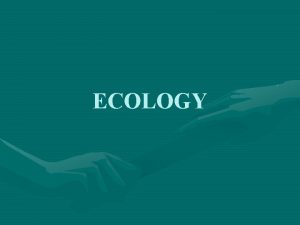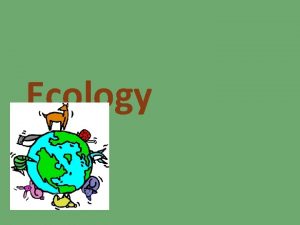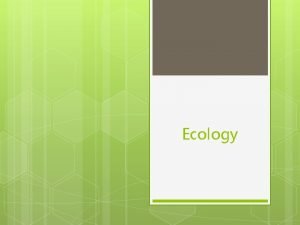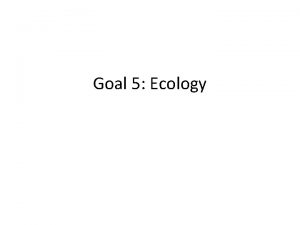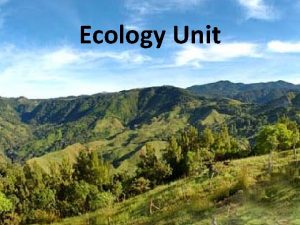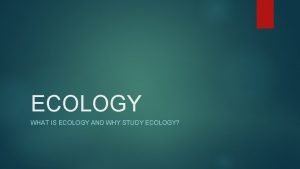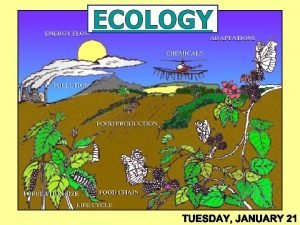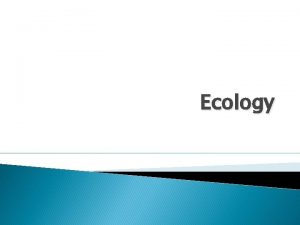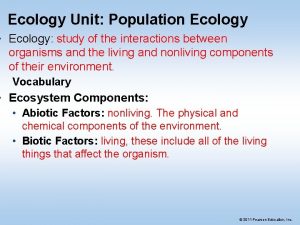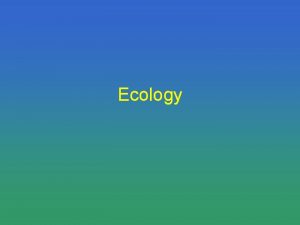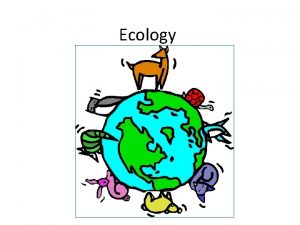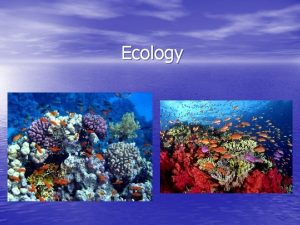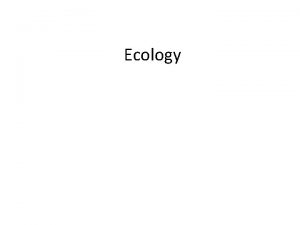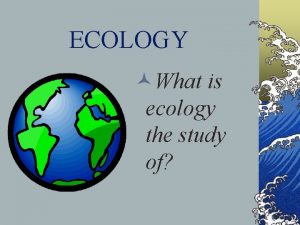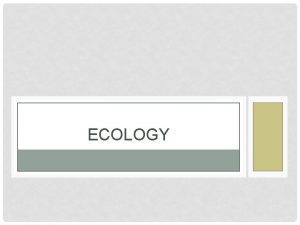WHAT IS ECOLOGY Ecology the scientific study of



























































- Slides: 59

WHAT IS ECOLOGY? Ecology- the scientific study of interactions between organisms and their environments, focusing on energy transfer Ecology is a science of relationships

WHAT DO YOU MEAN BY ENVIRONMENT? The environment is made up of two factors: • Biotic factors- all living organisms inhabiting the Earth • Abiotic factors- nonliving parts of the environment (i. e. temperature, soil, light, moisture, air currents)

Biosphere Ecosystem Community Population Organism

Organism - any unicellular or multicellular form exhibiting all of the characteristics of life, an individual. • The lowest level of organization • (that has all characteristics for life)

POPULATION ü a group of organisms of one species living in the same place at the same time that interbreed üProduce fertile offspring üCompete with each other for resources (food, mates, shelter, etc. )

Community - several interacting populations that inhabit a common environment and are interdependent.

Ecosystem - populations in a community and the abiotic factors with which they interact (ex. marine, terrestrial)

Biosphere - life supporting portions of Earth composed of air, land, fresh water, and salt water. • The highest level of organization

Habitat vs. Niche - the role a species plays in a community; its total way of life Habitat- the place in which an organism lives out its life

Habitat vs. Niche Limiting factor- any biotic or abiotic factor that restricts the existence of organisms in a specific environment.

Examples of limiting factors - • Amount of water • Amount of food • Temperature • Amount of space • Availability of mates

Symbiotic Relationships Symbiosis- two species living together 3 Types of symbiosis: 1. Commensalism 2. Parasitism 3. Mutualism

Symbiotic Relationships Commensalismone species benefits and the other is neither harmed nor helped Ex. orchids on a tree Epiphytes: A plant, such as a tropical orchid or a bromeliad, that grows on another plant upon which it depends for mechanical support but not for nutrients. Also called xerophyte, air plant.

Symbiotic Relationships Commensalismone species benefits and the other is neither harmed nor helped Ex. polar bears and cyanobacteria

Symbiotic Relationships Parasitismone species benefits (parasite) and the other is harmed (host) • Parasite-Host relationship

Symbiotic Relationships Parasitism- parasite-host Ex. lampreys, leeches, fleas, ticks, tapeworm

Symbiotic Relationships Mutualismbeneficial to both species Ex. cleaning birds and cleaner shrimp

Symbiotic Relationships Mutualismbeneficial to both species Ex. lichen


Type of Species relationship harmed Commensalism Parasitism Mutualism = 1 species Species benefits Species neutral

Feeding Relationships • There are 3 main types of feeding relationships 1. Producer - Consumer 2. Predator - Prey 3. Parasite - Host

Feeding Relationships Producer- all autotrophs (plants), they trap energy from the sun • Bottom of the food chain

Feeding Relationships Consumer- all heterotrophs: they ingest food containing the sun’s energy ØHerbivores ØCarnivores ØOmnivores ØDecomposers

Feeding Relationships CONSUMERS 1. Herbivores Primary consumers • Eat plants • Secondary, tertiary … consumers • Prey animals • Carnivores

Feeding Relationships Consumer-Carnivores-eat meat • Predators – Hunt prey animals for food.

Feeding Relationships Consumer- Carnivores- eat meat • Scavengers – Feed on carrion, dead animals

Feeding Relationships Consumer- Omnivores -eat both plants and animals

Feeding Relationships Consumer. Decomposers • Breakdown the complex compounds of dead and decaying plants and animals into simpler molecules that can be absorbed


Trophic Structure • A pattern of feeding relationships consisting of several different levels. • Trophic levels represent a feeding step in the transfer of energy and matter in an ecosystem.


• There are fewer and fewer organisms in each level.

Trophic Levels Food chain- simple model that shows how matter and energy move through an ecosystem


Trophic Levels Food web- shows all possible feeding relationships in a community at each trophic level • Represents a network of interconnected food chains

• Represents a network of interconnected food chains

Food chain (just 1 path of energy) Quaternary consumers Killer whale Hawk Tertiary consumers Tuna Snake Secondary consumers Mouse Herring Primary consumers Zooplankton Grasshopper Producers Plant A terrestrial food chain Phytoplankto An n aquatic food chain Food web (all possible energy paths)

Figure 37. 9 -1 Producers provide the chemical energy and nutrients used by all other members of the food web. Prickly pear cactus Mesquite Producers (plants) Brittlebush Saguaro cactus

Figure 37. 9 -2 Producers provide the chemical energy and nutrients used by all other members of the food web. Gila woodpecker Grasshopper mouse Primary consumer Grasshopper Harris’s antelope squirrel Desert kangaroo rat Harvester ants Saguaro cactus Prickly pear cactus Mesquite Producers (plants) Brittlebush Nutrient Transfer From Producers To Primary consumers

Figure 37. 9 -3 Producers provide the chemical energy and nutrients used by all other members of the food web. Red-tailed hawk Elf owl Gila woodpecker Western diamondback Grasshopper mouse Praying mantis Secondary consumer Primary and secondary consumer Collared lizard Primary consumer Grasshopper Harris’s antelope squirrel Desert kangaroo rat Harvester ants Saguaro cactus Prickly pear cactus Mesquite Producers (plants) Brittlebush Nutrient Transfer From Producers Primary consumers To Primary consumers Secondary consumers

Figure 37. 9 -4 Producers provide the chemical energy and nutrients used by all other members of the food web. Red-tailed hawk Secondary and tertiary consumer Secondary, tertiary, and quaternary consumer Elf owl Gila woodpecker Western diamondback Grasshopper mouse Praying mantis Secondary consumer Primary and secondary consumer Collared lizard Primary consumer Grasshopper Harris’s antelope squirrel Desert kangaroo rat Harvester ants Saguaro cactus Prickly pear cactus Mesquite Producers (plants) Brittlebush Nutrient Transfer From Producers Primary consumers Secondary consumers Tertiary consumers To Primary consumers Secondary consumers Tertiary consumers Quaternary consumers

5: 40

Trophic Levels Biomass- the amount of organic matter comprising a group of organisms in a habitat. • As you move through a food chain, both available energy and biomass decrease.

Trophic Levels • Energy is transferred but is diminished with each transfer. Only about 10% of energy is transferred. Tertiary consumers 10 kcal Secondary consumers 100 kcal Primary consumers 1, 000 kcal Producers 10, 000 kcal 1, 000 kcal of sunlight

Figure 37. 16 a Plant material eaten by caterpillar 100 kilocalories (kcal) 35 kcal Feces 50 kcal 15 kcal Growth 1 kcal = 1 Calorie (food calorie) Cellular respiration


Figure 37. 16 a Plant material eaten by caterpillar 100 kilocalories (kcal) 35 kcal Feces 50 kcal 15 kcal Growth 1 kcal = 1 Calorie (food calorie) Cellular respiration

Figure 37. 16 b Tertiary consumers 10 kcal Secondary consumers 100 kcal Primary consumers 1, 000 kcal Producers 10, 000 kcal 1, 000 kcal of sunlight

Humans – Primary, Secondary, or Tertiary Consumer? • • What level is our eating habits? Salad? Steak? Pepperoni Pizza? • If you eat a slice of pepperoni pizza, what consumer level would you be?

Figure 37. 17 Trophic level Secondary consumers Meat-eaters Primary Vegetarians consumers Producers Corn Cattle Corn

Biodiversity • The variety of living things including genetic diversity, species diversity, and ecosystem diversity.


Species Diversity • Two components – Species richness – the number of different species in a community – Relative abundance – the proportional representation of each species in a community

Species richness = # of different species Both have the same species richness Compare these 4 different species, but different relative abundance Relative abundance = proportions of the species

Table 37. 10

Some species can have a larger impact than others on ecosystems. What are some examples?

Keystone species Keystone • A species whose impact on the community is much larger than its biomass or abundance would indicate Keystone absent

Yellowstone

Yellowstone
 Scientific inquiry vs scientific method
Scientific inquiry vs scientific method How is a scientific law different from a scientific theory?
How is a scientific law different from a scientific theory? Ecology study guide answers
Ecology study guide answers Chapter 3 section 1: community ecology answer key
Chapter 3 section 1: community ecology answer key Ecology is the study that helps to preserve
Ecology is the study that helps to preserve Linguistics as a scientific study of language
Linguistics as a scientific study of language Social psychology is the scientific study of
Social psychology is the scientific study of Herbert spencer introduction
Herbert spencer introduction Scientific study of social behavior and human groups
Scientific study of social behavior and human groups The scientific study of trees
The scientific study of trees The scientific study of behavior and mental processes
The scientific study of behavior and mental processes Finished files are the result
Finished files are the result Types of ergonomics
Types of ergonomics Mendelian genetics vocab
Mendelian genetics vocab Hát kết hợp bộ gõ cơ thể
Hát kết hợp bộ gõ cơ thể Lp html
Lp html Bổ thể
Bổ thể Tỉ lệ cơ thể trẻ em
Tỉ lệ cơ thể trẻ em Voi kéo gỗ như thế nào
Voi kéo gỗ như thế nào Thang điểm glasgow
Thang điểm glasgow Hát lên người ơi
Hát lên người ơi Môn thể thao bắt đầu bằng chữ đua
Môn thể thao bắt đầu bằng chữ đua Thế nào là hệ số cao nhất
Thế nào là hệ số cao nhất Các châu lục và đại dương trên thế giới
Các châu lục và đại dương trên thế giới Cong thức tính động năng
Cong thức tính động năng Trời xanh đây là của chúng ta thể thơ
Trời xanh đây là của chúng ta thể thơ Mật thư anh em như thể tay chân
Mật thư anh em như thể tay chân Làm thế nào để 102-1=99
Làm thế nào để 102-1=99 Phản ứng thế ankan
Phản ứng thế ankan Các châu lục và đại dương trên thế giới
Các châu lục và đại dương trên thế giới Thơ thất ngôn tứ tuyệt đường luật
Thơ thất ngôn tứ tuyệt đường luật Quá trình desamine hóa có thể tạo ra
Quá trình desamine hóa có thể tạo ra Một số thể thơ truyền thống
Một số thể thơ truyền thống Cái miệng nó xinh thế chỉ nói điều hay thôi
Cái miệng nó xinh thế chỉ nói điều hay thôi Vẽ hình chiếu vuông góc của vật thể sau
Vẽ hình chiếu vuông góc của vật thể sau Thế nào là sự mỏi cơ
Thế nào là sự mỏi cơ đặc điểm cơ thể của người tối cổ
đặc điểm cơ thể của người tối cổ V cc
V cc Vẽ hình chiếu đứng bằng cạnh của vật thể
Vẽ hình chiếu đứng bằng cạnh của vật thể Phối cảnh
Phối cảnh Thẻ vin
Thẻ vin đại từ thay thế
đại từ thay thế điện thế nghỉ
điện thế nghỉ Tư thế ngồi viết
Tư thế ngồi viết Diễn thế sinh thái là
Diễn thế sinh thái là Dot
Dot Thế nào là số nguyên tố
Thế nào là số nguyên tố Tư thế ngồi viết
Tư thế ngồi viết Lời thề hippocrates
Lời thề hippocrates Thiếu nhi thế giới liên hoan
Thiếu nhi thế giới liên hoan ưu thế lai là gì
ưu thế lai là gì Hổ sinh sản vào mùa nào
Hổ sinh sản vào mùa nào Sự nuôi và dạy con của hươu
Sự nuôi và dạy con của hươu Hệ hô hấp
Hệ hô hấp Từ ngữ thể hiện lòng nhân hậu
Từ ngữ thể hiện lòng nhân hậu Thế nào là mạng điện lắp đặt kiểu nổi
Thế nào là mạng điện lắp đặt kiểu nổi Case series
Case series Retrospective cohort study
Retrospective cohort study Work study definition
Work study definition Marty lobdell
Marty lobdell




